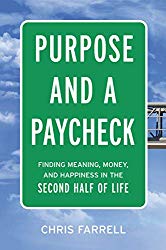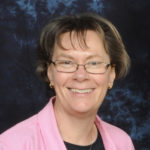Purpose and a Paycheck – Finding Meaning, Money, and Happiness in the Second Half of Life by Chris Farrell
 Purpose and a Paycheck paints a positive outlook for people in the second half of life. Chris Farrell, a writer for Next Avenue and expert on workforce topics affecting people over 50, shares many examples of the ways in which older workers are thriving around the world.
Purpose and a Paycheck paints a positive outlook for people in the second half of life. Chris Farrell, a writer for Next Avenue and expert on workforce topics affecting people over 50, shares many examples of the ways in which older workers are thriving around the world.
There are Contrasting Viewpoints
I read this book just shortly after listening to several interviews with Elizabeth White, author of 55, Underemployed and Faking Normal which was also recently reviewed on Career Pivot. White spins a darker story about the working lives of people in the same age group. I’m going to review Farrell’s book with a few references to where White tells a different story.
We Can Agree on a Few Things
Both authors agree that the US society and many employers hold negative views about the health and working abilities of this age cohort. People over 50 are a growing segment of the population but seem to be losing jobs at a faster pace than younger people. These losses affect not only people with low levels of skills and education who had physically demanding jobs, but also folks who held prestigious, high paying jobs that required networking and great credentials to land. These workers also lose employment support resources as they age. Their networks, friends, and mentors are retiring, dying, and being forced out of the workforce by employers who do not see the ROI on the contributions of older workers.
But Not on Everything
One of the most interesting contrasts is the portrayal of the financial status of older Americans. Farrell notes this is fiercely debated, and no consensus exists. He contends the older Americans most in danger of living in poverty are those with disabilities, who lost a spouse, or who have jobs without retirement benefits. White, on the other hand, cites statistics showing that very few people over 50 have adequate retirement savings, and it can be difficult to find work that transitions from their great job of yesterday to an adequate job for survival today.
Farrell feels confident employers will soon be forced to realize they’ve been discounting a significant source of high-quality workers. Elizabeth, on the other hand, shares many stories illustrating this is not currently the case. Her book focuses on survival strategies for older people who have lost professional jobs.
Societal Perceptions Are Wrong
Farrell in a Purpose and a Paycheck describes how older workers are not what society perceives them to be. He notes they are forming businesses at a high rate, that older cohorts are seeing their workforce participation rates rise faster than younger cohorts (NOTE: if there aren’t many older people working, it’s easier to calculate a high percent change.) He also feels that with the current ultra-low unemployment rate that employers will have to turn to older workers to fill their job openings. There is some evidence this is happening; workforce participation rates are creeping up for older workers. The older worker trend seems to be starting with smaller companies, which I suspect are less reliant on Applicant Tracking Systems (ATS) that bypass older applicants.
Older Workers Are Healthy and Wise
The book debunks the perception that older people are less capable than younger people, citing examples of creative workers and athletes who continued to work later in life and developed new and different phases of their work. Research showing that mental capacity and ability to learn to stay strong in older workers is cited as well. The slight physical declines with age are offset by better decision making, hence fewer serious mistakes on the job. Some abilities improve with age, this is not widely appreciated.
Older people are generally healthy; it’s not until you start looking at the 75+ age cohort that more than half of people have even one major health issue, three-quarters of people 55-64 have no significant health problems at all.
Pockets of Positivity
Purpose and a Paycheck shares many examples of older workers who exemplify the title of his book. He shares profiles of people who did some of their most creative work after the age of 50, people shifting careers and finding new meaning in work. There are entrepreneurs and people working together across generations to build a business that will last. Older people are starting businesses and adopting new technology to allow them to participate in the workplace from anywhere. People are judiciously retraining to follow new careers in line with their evolving interests. People decide to take jobs and start organizations that serve a social need that they have always wanted to address.
Making the World a Better Place
Farrell closes Purpose and a Paycheck with suggestions for policy changes which would benefit older workers and all workers by improving workplace age diversity. He feels policies that would protect people and make their health/retirement benefits portable, would be especially beneficial.
He ends with a call to action for older workers to take action. He tells them to be proactive in managing their careers, fighting stereotypes, and be open to new ways of living and working that extend their productive years and allow them to live a life they enjoy.
Not Quite My World – Is it Yours?
If you’re looking for a hopeful view of the lives and possibilities open to people in the second half of life, this is a terrific book. It’s full of research that confirms that most people over 50 are healthy, capable and even better workers than they were in their youth. Farrell ends with a call for older workers to take action, be proactive in managing their careers, fight the stereotypes, and be open to new ways of living and working that extend their productive years and allow them to live a life they enjoy.
However, if like me, you’re not feeling fabulous about how your age and abilities are affecting your employability, the examples may feel more aspirational than real. White’s tales of bias, bad luck, and fateful missteps may ring truer and her survival tactics may seem more relevant than Farrell’s inspirational stories. I think Purpose and a Paycheck is a worthy read, and it can lend hope that the malaise affecting some un- and under-employed people in the second half of life will not last.
 This was written by Cleo Parker. Cleo is a marketing insight and analytics professional with a background in advertising who currently lives with her husband in a suburb of Detroit, Michigan. She is also a lifelong purebred dog enthusiast and was recently approved to become a licensed AKC judge. Cleo combines her professional and personal interests in her Dog Marketing Blog and is working on a career pivot that sells her marketing expertise to dog clubs and businesses.
This was written by Cleo Parker. Cleo is a marketing insight and analytics professional with a background in advertising who currently lives with her husband in a suburb of Detroit, Michigan. She is also a lifelong purebred dog enthusiast and was recently approved to become a licensed AKC judge. Cleo combines her professional and personal interests in her Dog Marketing Blog and is working on a career pivot that sells her marketing expertise to dog clubs and businesses.
Like What Your Read? Get Career Pivot Insights
Do You Need Help With ...

Check out our Help Center where you have access to 14 different content portals.

Outstanding comparison between the two books I read Elizabeth White’s book where I found her book like Cleo mentioned a survival reality guide to life after 50. I think we need both types of career guides for those in their post 50s one that is uplifting reassuring about our career prospects the other by White a planning guide with consequences for those who fail to plan for their post-employment future. Farrell is right on to mention the new opportunities that exist for boomers launching an online business, contracting, free-lancing or reskilling for new opportunities in Healthcare, technology even education is experiencing shortages in Math, Science and Special education teachers so there are myriad of paths to success and long-term employment for the over 50 crowd. Who ever thought Cleo could be a dog marketer? I mean is there a certificate for dog marketing can you learn that topic in college?